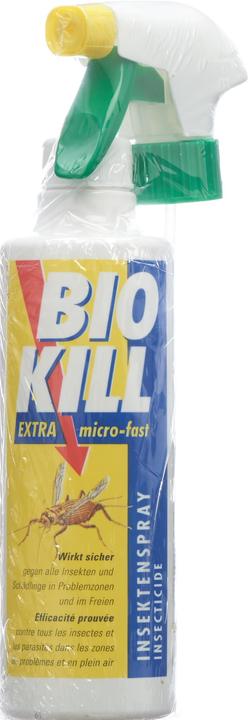

Ant alert! How to get rid of these pesky critters
As the saying goes, it’s a bug’s life – and in many households, ants seem to be really living it up this year. I asked pest control expert Gabi Büller for advice on how to keep them at bay.
Suddenly, there they are – little black dots scurrying across your floor. Ants can be a pain, but imagine if you had them crawling around your house all year long. And for 25 years at that. Horrible thought, right? Not so for Gabi Müller, who’s been at the helm of the Canton of Zurich’s «Schädlingspräventionsfachstelle» (Pest Prevention Unit) for the past quarter century.

Source: City of Zurich
Zurich residents reach out to the biologist more than 200 times a year in relation to ants. They call, show up at her office or send her letters containing insects to be identified. «After wasps, ants are the insect we deal with most frequently,» Müller says.
The problem is, getting rid of ants is no easy feat. Each species responds to different means of pest control, with tastes sometimes even changing within a colony. While creepy-crawlies might love a particular bait one minute, they might start avoiding it within the space of a month. So what can be done?
Step 1: identification
«The most important first step is to determine whether the ants are native or exotic,» Müller explains. Here’s how it works:
What native ants look like
Ants native to Switzerland are usually two-tone: black, then reddish brown, then black. The most common species in Switzerland are the Lasius niger, Lasius emarginatus and Lasius brunneus. They often appear on balconies and in homes as early as spring, when food is still in short supply outside. Here’s what they look like:

Source: City of Zurich
How to spot exotic ants
Non-native ants are often smaller, and the same colour all over. Rather than limiting their activities to the period between spring and late summer, they’re active in homes all year round. You should be especially wary of smaller, amber-coloured bugs as they might be pharaoh ants, which can infest entire streets. Here’s what they look like:

Source: Canton Zurich
The biting Tapinoma nigerrimum is particularly invasive. This year, several colonies had to be removed after they infested a large area of Winterthur (article in German). What makes this species especially tricky is that they look similar to the native Lasius niger:

Source: Canton Zurich
Admittedly, identifying the exact species can be difficult for a layperson. If you suspect you’ve got an exotic ant infestation on your hands, it’s important to act quickly. «The best thing to do is have the ants identified by a professional, perhaps someone from a nature museum or pest control company. The main thing is to ensure they have the Swiss special licence for general pest control,» Müller explains.
If you suspect you’ve got an exotic ant infestation on your hands, it’s important to act quickly.
Most of the time, however, calling in pest control isn’t immediately necessary. «If you discover native ants in spring, you should give it some time,» Müller says. «Once there’s food outside again, they’re often gone as quickly as they came.»
However, they do sometimes stick around.
Step 2: getting rid
The expert advises against these home remedies
If native ants have taken up residence in your home, there are a variety of ways to get rid of them. Home remedies such as these are often touted on the internet:
- baking powder with icing sugar
- cinnamon
- dried mint
- nettle fertiliser
- rubbing alcohol with detergent
Gabi Müller takes a sceptical view of home remedies. Although they may work in individual cases, she says chemicals are most effective.
These chemicals help
There’s also a wide range of chemical agents for tackling ants:
But which one works best? And which ones are absolutely no good?
«Sealing up openings rarely helps. The ants often either get through anyway or look for a place next to it,» Müller explains. «Spray isn’t of much use either.» Why? Because sprays only allow you to kill stray workers. The queen in the nest, however, will survive and go on producing offspring. Spraying ants crawling around in front of a bait can even be counterproductive, as the dead ants scare their comrades away from it. In fact, according to Gabi Müller, this very bait is the easiest and best solution.
Ant bait is the simplest and best solution.
It’s hard to say which bait is best to use. «Ants have very individual tastes, so there’s no silver bullet. You need to figure out what works for yourself.»
How to find the best bait
You’re best off buying ant bait from several different brands. Put it down in all the places you see an especially high number of ants scurrying around. Watch which bait they crawl to. If one bait draws in more ants after a few days, even better – this means it’s popular. However, it also means it might run out quickly. So keep an eye on the set-up to see which bait the ants go to most often. If the number of ants decreases, it’s worth replacing the bait (often after about 14 days). The good thing about this is you’ll now know which brand to go for.
You’re best off buying ant bait from several different brands.
The «magic bullet»
According to Gabi Müller, bait gel is even more effective than getting the right bait. This, however, is only used by pest control professionals. It’s also used, for instance, when pest control is called in to fight an exotic ant infestation (see above). These ants have not just one, but numerous queens, allowing them to multiply to an invasion-level degree.
Step 3: prevention
Of course, keeping ants away is better than killing them. Although there’s no magic remedy when it comes to prevention either, Gabi Müller has a few tips:
- Store sugary foods in well-sealed containers and wipe stains off surfaces.
- Remove aphids from your plants as ants love feeding on their excretions (honeydew). Sometimes ants herd aphids (like we do with cows), milk them and defend them against predators.
- Keep a space between plants and the façade of your house or apartment building. The best way to do this is with a strip of gravel about 50 centimetres wide, which you’ll need to weed regularly. That way, you’ll make it more difficult for ants to climb up the side of the building.
- Keep an eye on protected spots such as insulation access points or wooden parts. These are the areas insects especially like settling in.
Don’t bring in any exotic varieties
One thing that particularly concerns Gabi Müller is the introduction of exotic ant species. As a result, she advises against importing potted plants from abroad. «There might be insects in the soil of that olive tree you bought when you were on holiday in Italy. I once got called out to Northeastern Switzerland because of soil termites that probably came into the country in potting soil,» Müller says.

Source: Shutterstock/Witsawat.S
The biologist sees the introduction of foreign species, in addition to global warming, as another reason why Zurich’s pest control service has been receiving an increasing number of ant-related enquiries over the past three years. They’ve already been contacted 195 times about ants this year. That means last year’s figure of 207 might be topped soon.
75235747 "The City of Zurich’s pest control service has seen the number of annual ant-related enquiries double compared to some previous years."In spite of all this, Müller is glad that the reputation of insects in general has improved. «In the past, people just wanted to exterminate wasps. Nowadays, they’re increasingly asking for them to be relocated.»
Ants: the all-rounders of the insect world
And rightly so, insects really are jacks-of-all-trades. Ants form humus and loosen the soil, spread the seeds of wild plants, eat pests and are valuable food sources to other animals.
So the next time ants are driving you crazy, remember that if we didn’t have them scurrying around, our world could soon come to a standstill.
How do you deal with ants? Let me know in the comments.
Header image: ShutterstockI like anything that has four legs or roots. The books I enjoy let me peer into the abyss of the human psyche. Unlike those wretched mountains that are forever blocking the view – especially of the sea. Lighthouses are a great place for getting some fresh air too, you know?



